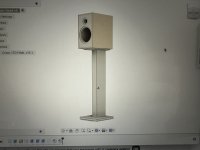sebr023
Member
Hi all!
I’m a weekend warrior. I don’t do this professionally. I’d be happy to splurge on a nice domino, but I don’t have this kind of money now, one day!
I’m having a hard time deciding of which Jessem doweling jig to get. I don’t see much difference between them except one is stainless and the other is aluminium. The aluminium one has already the dowel size on them, aluminium one you need to change the size.
[attachimg=1]
I’m thinking of getting it for my speaker stand project.
I’m thinking of making the leg 3x6in. Using 3/4in mdf, I would laminate it to get 3in “thick” and think dowel would help somehow, for registration?! Maybe only glue would be enough? If I cut them a bit over size and then rip them to size on table saw?!
What you guys think?
[attachimg=2]
I’m a weekend warrior. I don’t do this professionally. I’d be happy to splurge on a nice domino, but I don’t have this kind of money now, one day!
I’m having a hard time deciding of which Jessem doweling jig to get. I don’t see much difference between them except one is stainless and the other is aluminium. The aluminium one has already the dowel size on them, aluminium one you need to change the size.
[attachimg=1]
I’m thinking of getting it for my speaker stand project.
I’m thinking of making the leg 3x6in. Using 3/4in mdf, I would laminate it to get 3in “thick” and think dowel would help somehow, for registration?! Maybe only glue would be enough? If I cut them a bit over size and then rip them to size on table saw?!
What you guys think?
[attachimg=2]



